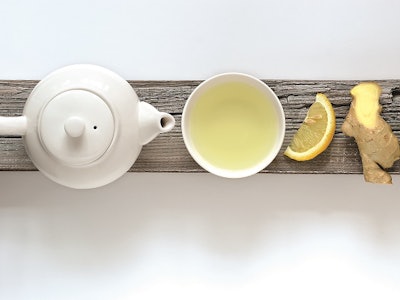
Extract, Essences and Flavors
In tea beverage applications, tea extracts, acids, various flavors, sweeteners and preservatives are generally used to make ready-to-drink (RTD) teas; however, the overall taste of RTD teas is mostly decided by flavor choices. It is common for RTD teas to be sold as functional beverages, which are beverages intended to deliver health benefits. In these tea beverages, the functional compounds are polyphenolics (catechin in green tea and theaflavin and thearubigin in black tea) and caffeine. These ingredients are naturally present in the tea extracts and are used for tea beverage applications.
Choosing the right tea extract is important for enhancing functionality because gently processed tea contains more functional compounds due to less exposure to heat, light and pressure. Most tea extracts are processed under tough conditions to increase extraction yields and processing efficiencies; however, tea extracts can also be produced in gentle processing facilities to minimize loss of functionality, prevent flavor degradation and provide more tea flavors.
Tea used in beverage applications is naturally extracted by methods including expression, absorption, maceration and distillation using natural solvents, such as ethanol or water from naturally sourced raw materials. Two different products can be obtained from the natural extraction process, which include flavors that contain volatile compounds such as furfural, linalool and limonene, as well as extracts that contain non-volatile compounds such as polyphenolics, caffeine, vitamin, protein and carbohydrates.
Tea extracts are naturally extracted either by ethanol or water, but most often tea flavors are extracted by water because most volatile compounds in tea leaves are water soluble. Additionally, water is always the preferred solvent in beverage industry because consumers know water to be clean and natural and all around good for them.
"Flavor companies are looking at unique systems to help maintain tea’s natural and delicate flavor throughout processing, delivering true tea flavor profiles for any type of tea beverage application."
When it comes to the actual beverage development for tea, extracts are used to give bitterness, astringency, body and health benefits, and essences add unique and fresh tea flavors to tea beverages.
For RTD tea applications, the overall taste of tea beverages is heavily decided by the addition of tea essences because they add the real tea flavors to tea beverages. Without essence, tea beverages would not have individualized tea flavors. Depending on what kind of tea essence is used and how much is added into the beverage, the quality of the tea beverage can vary. Currently, lemon and peach are the most popular flavoring choices for tea beverages followed by pomegranate, mint, mango, orange and berry; however, new flavors such as ginger, super fruits and coconut have been gaining popularity.
In the current domestic and global beverage market, there is a trend toward functional drinks as customers move away from the consumption of soft drinks. This is because more and more customers are becoming aware of the high amounts of sugar in soft drinks, and the negative impact it has on their health. Because of this growing health-related trend, the tea market is getting bigger as customers are looking for healthy beverage alternatives, such as RTD teas.

To win the functional beverage market, which is the hottest category in the global beverage market, tea is enhanced with tea extracts that already have health benefits and is then further strengthened with other functional ingredients. Examples include energy drinks with tea extracts and tea beverages with other natural extracts, such as ginseng and guanara. As some of the most popular functional ingredients, tea extracts have become essential ingredients for many different types of functional beverages in health and wellness (e.g. vitamin water), energy and stimulation (e.g. energy drinks), hydration (e.g. sports drinks) and weight management (e.g. weight loss drinks). The active compounds that aid functionality in tea extracts are polyphenolics and caffeine, as previously mentioned, and the amount and stability of these components may vary by growing conditions, harvesting time, degree of processing and age of the tea leaves.
Flavor companies are looking at unique systems to help maintain tea’s natural and delicate flavor throughout processing, delivering true tea flavor profiles for any type of tea beverage application. Tea essences extracted by advanced steam distillation processes provide freshly brewed flavors and clean label options. Also, the gentle processing helps keep healthful compounds from thermal degradation throughout tea extraction process. These health benefits can be delivered to the products made by tea extracts due to high concentration of antioxidant polyphenolic concentration, which consists primarily of flavonoids.
Health Benefits of Tea
Tea consumption has been increasing worldwide due to its health benefits provided by the polyphenolics. Tea has a significant amount of these polyphenolic flavonoids, which exhibit potent antioxidant capacity when tested using in vitro (controlled environment outside of a living organism)and in vivo (inside a living organism) methods. Numerous observations and experimental studies have reported that polyphenolic compounds found in tea may reduce the risk of various illnesses, such as cancer and coronary heart disease, which are two of the leading causes of death among Americans.1 The good news is abundant experimental investigations and epidemiological surveys have shown that polyphenolic flavonoids present in teas have reduced the risk of cancer in the past decade. For example, evidence of the anticarcinogenic potential of tea polyphenols was proven in many experimental studies by indicating their binding property to carcinogen and inhibiting heterocyclic amine (carcinogenic compound in cooked meat) formation.2
"Consumption of tea is also known to be effective in improving overall human health."
Teas were also tested for health benefits based on the type of tea. Since black tea is the most predominantly consumed tea in the U.S. and European countries, several studies were conducted to investigate the effects of black tea consumption against cancer; however, it was found that black tea consumption is not as effective as green tea consumption at preventing cancer. This is because green tea, unlike black tea, contains catechins, such as epicatechin gallate, epigallocatechin gallate and epigallocatechin that show higher anticarcinogenic property than theaflavin.3 This was found to be true with the occurrence of breast cancer, which is the most common cancer among women, and the fifth most common cause of death among cancer.4 The consumption of green tea was found to be inversely related to the occurrence of breast cancer because estradiol (female hormone) and sex hormone-binding globulin (glycoprotein binding to testosterone and estradiol), which cause breast cancer onset, were positively changed. It has also been reported that tea flavonoids, such as epigallocatechin gallate, epigallocatechin and the aflavin-3-3’-digallate sufficiently inhibited the growth of lung tumors and increased lung DNA repair when tested on mice lungs.5
Consumption of tea is also known to be effective in improving overall human health. For example, tea consumption has been found to lower obesity by stimulating hepatic lipid metabolism, inhibiting lipase, stimulating thermogenesis, modulating appetite and synergizing with caffeine. It was also reported that consistent drinking of normal strength tea significantly reduced the development of hypertension.6
Conclusion
Overall, tea is becoming a widely popular choice of beverage for customers due to its convenience in its RTD form, as well as its natural ingredients and health benefits, which cannot be found in many other beverage categories.
About the Author

Dr. Youngmok Kim has a masters degree in food science from the University of Florida at Gainsville, FL and a PhD in food science from Texas A&M University at College Station, TX. He has used his knowledge at Synergy Flavors for nine years. As a tea senior research scientist, he actively conducts research on tea, tea beverages, tea ingredients and the health benefits of tea. He also develops new functional and natural products with enhanced color, stability, clarity and nutritional value by operating analytical instruments for qualitative and quantitative data.











